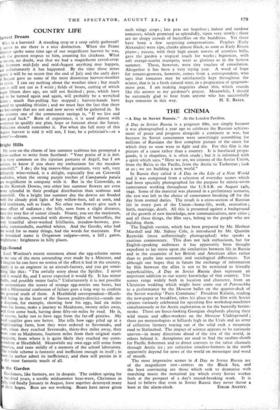THE CINEMA
"A Day in Soviet Russia." At the London Pavilion.
A Day in Soviet Russia is a poignant film, not simply because it was photographed a year ago to celebrate the Russian achieve-: ment of peace and progress alongside a continent at war, but because its Soviet cameramen were unwittingly assembling for millions of Russians the first complete picture of the cause for which they so soon were to fight and die. For this film is the picture of a cause rather than a country. It is barefaced propa- ganda, it is shapeless, it is often crude ; but it is informed with a spirit which says, " Here we are, we citizens of the Soviet Union, from the Baltic to the Pacific, from the Arctic to Turkestan ; look at us ; we are building a- new world."
In Russia they called it A Day in the Life of a New World and it was composed from a selection of everyday scenes which had been specially photographed for the purpose by ninety-seven cameramen working throughout the U.S.S.R. on August 24th, 1940. Some of the material was planned in a preliminary scenario, the rest was left to the choice of cameramen breaking off for the day from normal duties. The result is a cross-section of Russian life in every part of the Union—home-life, work, recreation ; birth, marriage, death. All this is presented against a background of the growth of new knowledge, new communications, new cities ; and all these things, the film says, belong to the people who are building them.
The English version, which has been prepared by Mr. Herbert Marshall and Mr. Sidney Cole, is introduced by Mr. Quentin Reynolds (most unflatteringly photographed) who speaks a cautious commentary. This does not lack enthusiasm, but for English-speaking audiences it has apparently been thought expedient to lay stress upon the similarities between life in Russia and in the countries of her British and American allies rather than to probe into economic and sociological differences. Yet although one hopes that in future the exchange of information by film between the allies is not to be restricted to friendly superficialities, A Day in Soviet Russia does represent an important addition to our scanty knowledge of that country. 1 he scenes range widely both in location and character, from an Ukrainian wedding which might have come out of Petrouchka to a performance by the Moscow ballet on the quarter-deck of the Soviet warship ' Paris Commune.' President Kalinin, reading the newspaper at breakfast, takes his place in the film with Soviet citizens variously celebrated for operating five workshop-machines simultaneously or for Arctic exploration or for the butterfly breast- stroke. There are fierce-looking Georgian shepherds playing their wild music and office-workers on the Moscow Underground ; there are meteorologists at billiards high in the Urals and an army of collective farmers tearing out of the solid rock a mountain road to Stalinabad. The impact of science appears to be curiously uneven—in many directions ahead of the rest of the world, in others behind it. Aeroplanes are used to find the sardine-shoals for Pacific fishermen and to direct convoys to the safest channels through Arctic ice ; yet collective reindeer-farmers in the north apparently depend for news of the world on messenger and word of mouth.
The most impressive scenes in A Day in Soviet Russia are of the magnificent rest - centres on the Black Sea, and the least convincing are those which seek to dramatise 'with marching music the matutinal joy which every Soviet worker feels at the prospect of a day's record-breaking work. It is hard to believe that even in Soviet Russia they never throw a


























 Previous page
Previous page